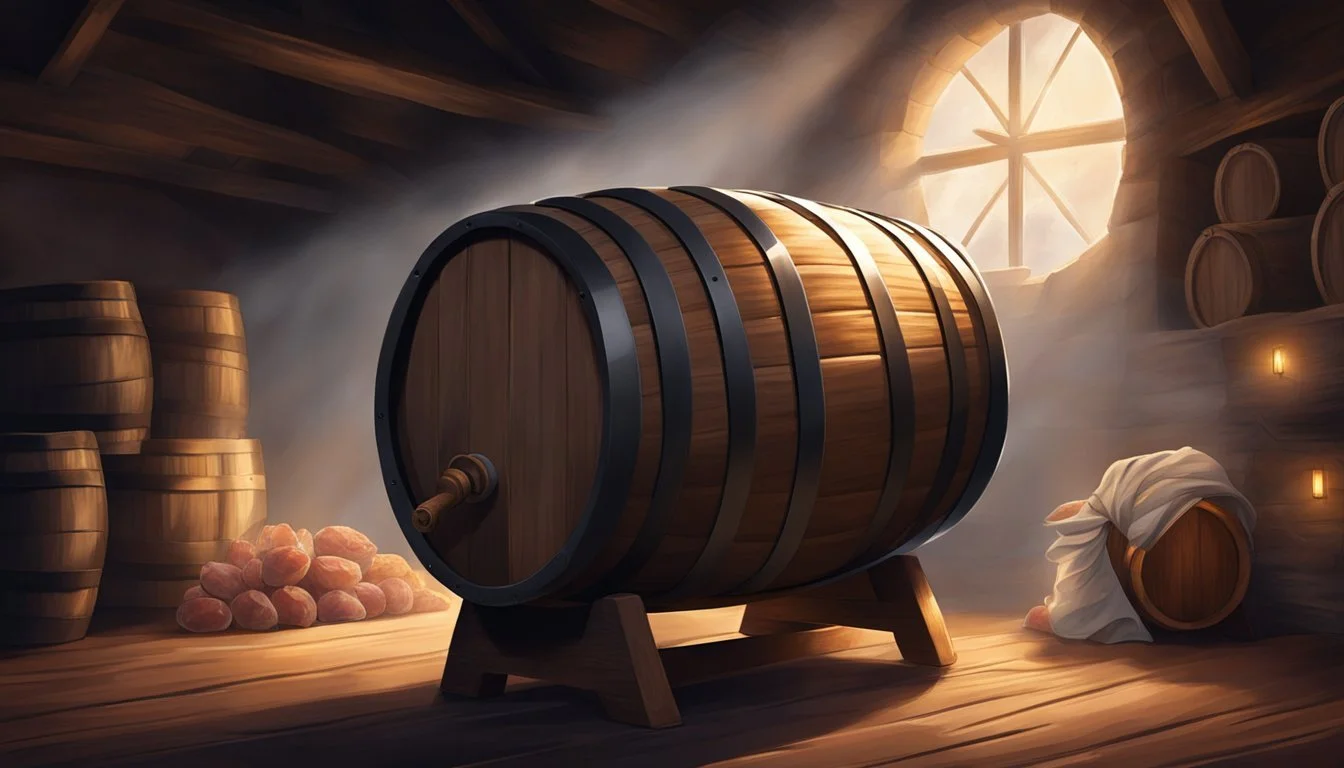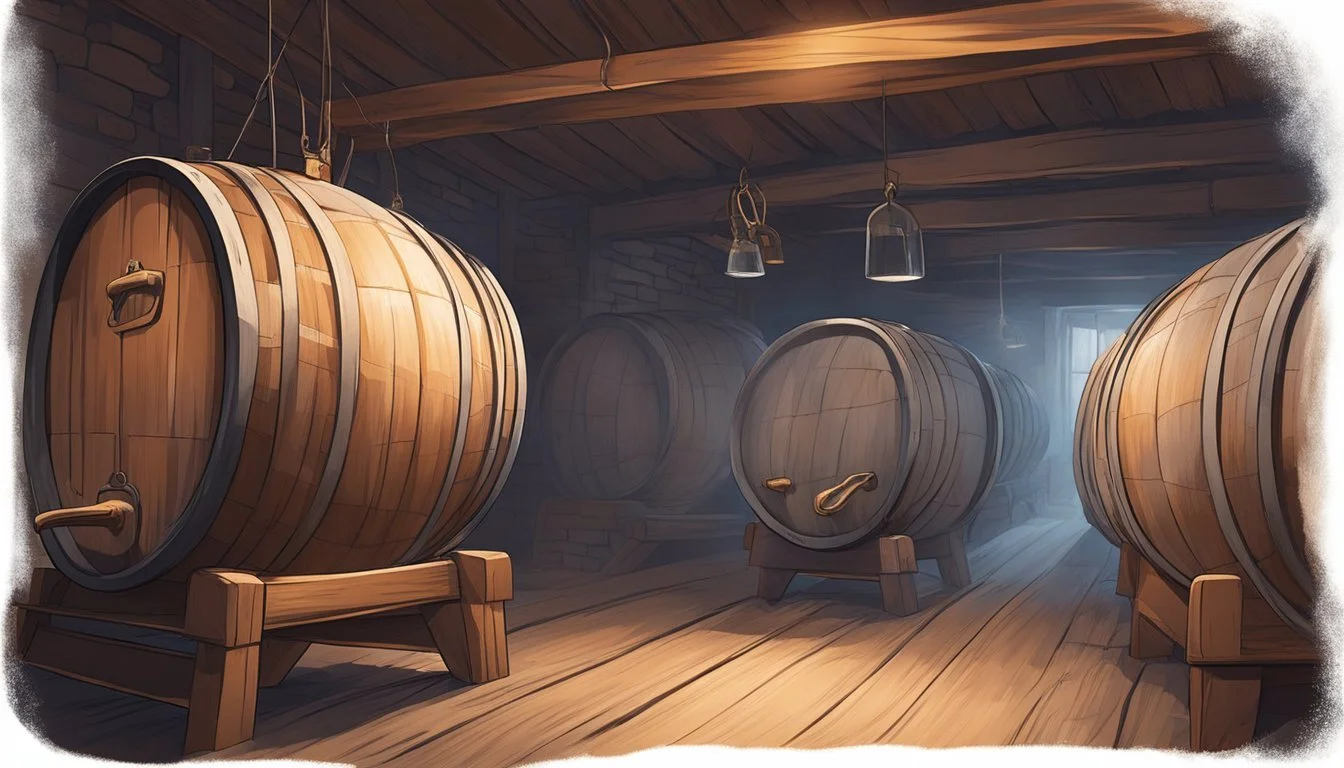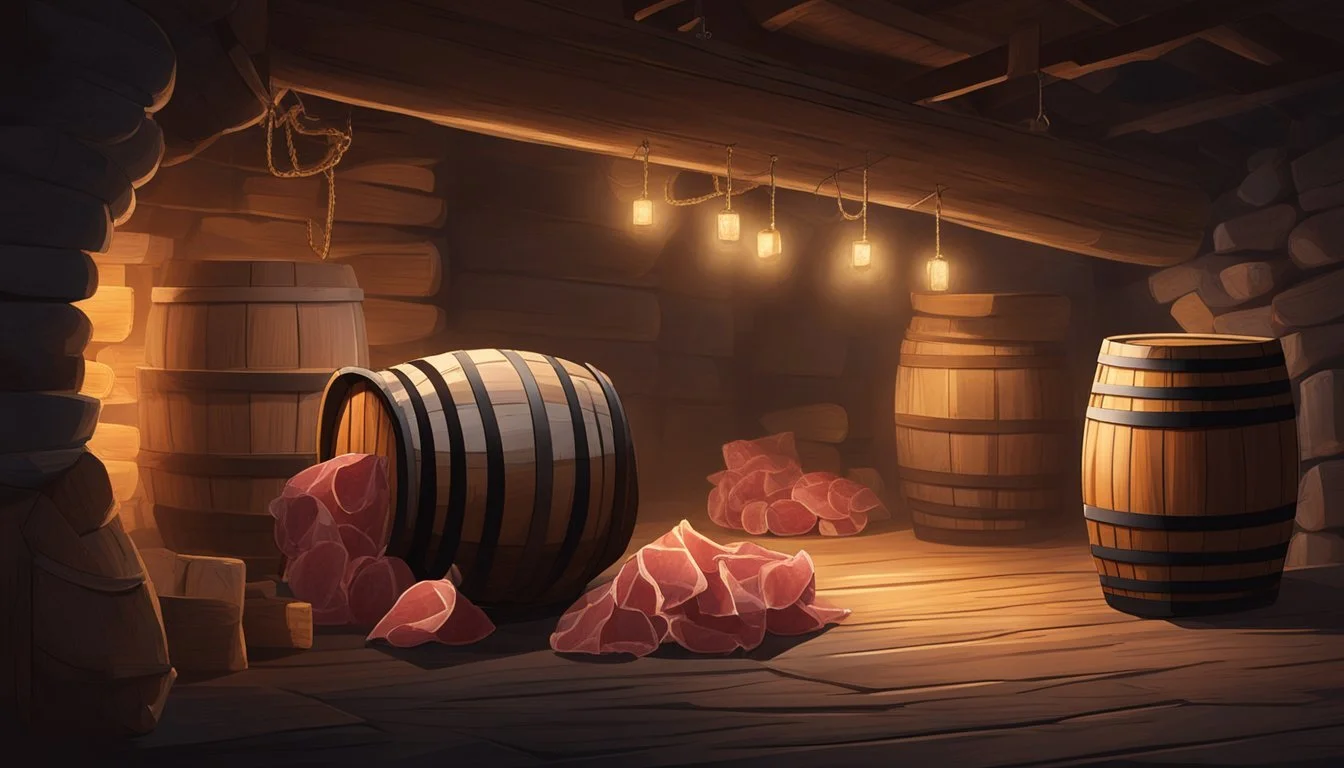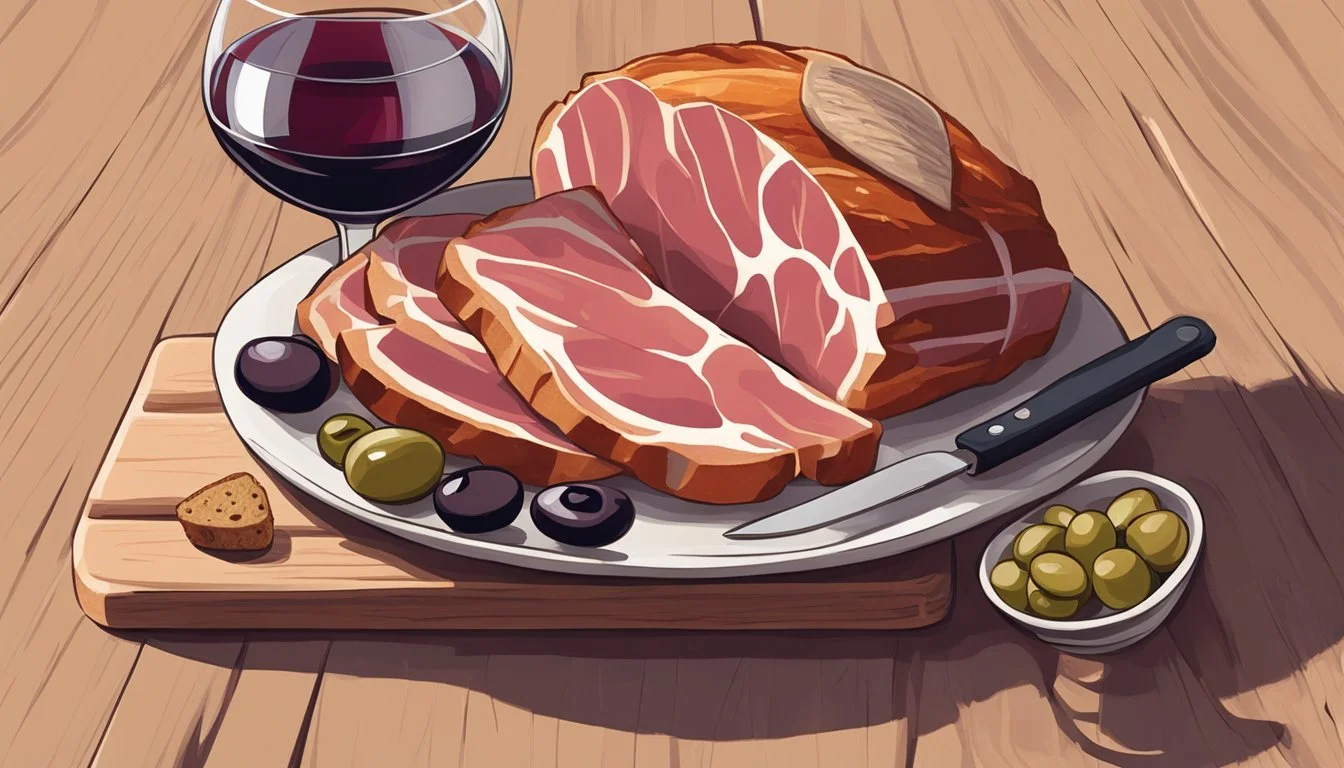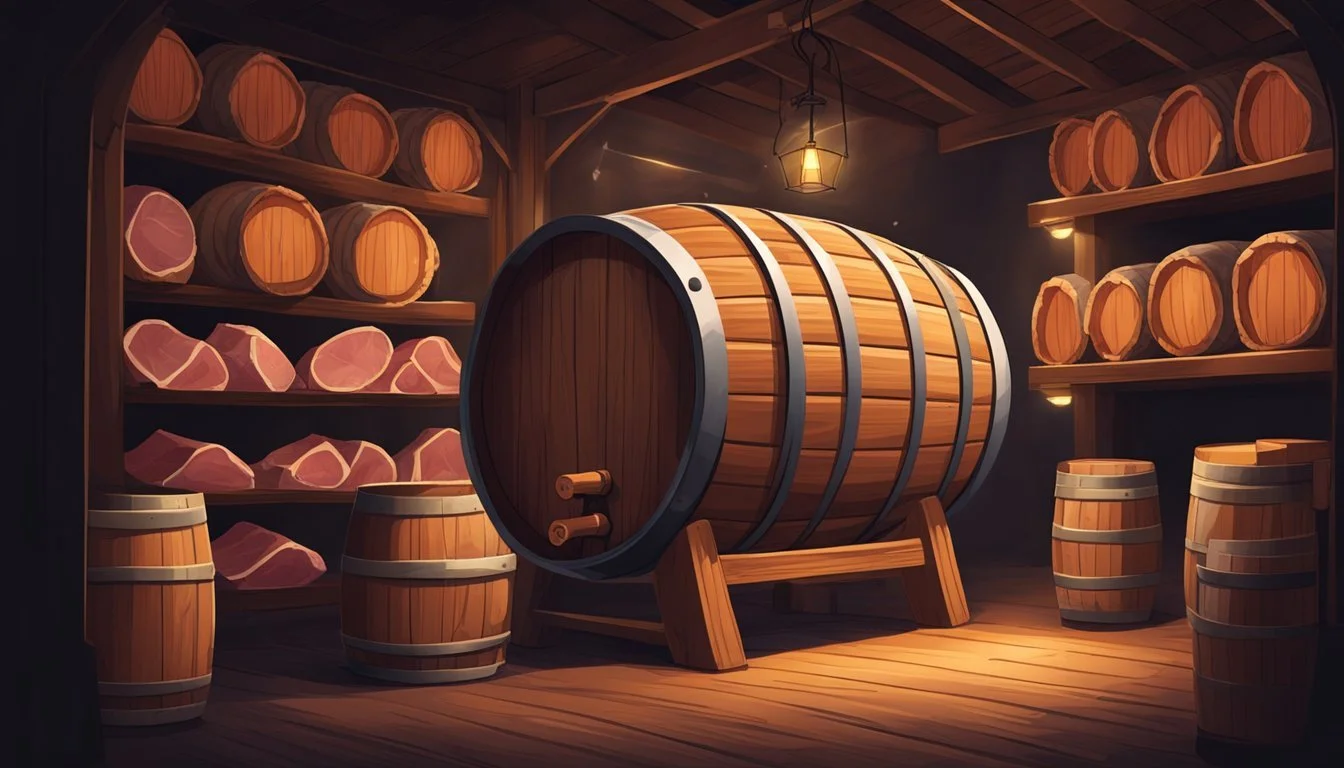How to Ferment Jamón Ibérico
Mastering Spanish Cured Ham Techniques
Jamón Ibérico, also known as Iberian ham, is a type of cured ham produced in Spain that is renowned for its rich, nuanced flavor and smooth texture. The process of fermenting and curing this exquisite ham is rooted in centuries-old traditions. It involves the meticulous selection of Iberian pigs, which are native to the Iberian Peninsula. These pigs are usually fed a diet rich in acorns, particularly during the last phase of their lives, which significantly enhances the quality of the meat. This distinctive diet is what gives Jamón Ibérico its unique taste that is cherished by gourmets around the world.
The fermentation of Jamón Ibérico is a critical stage in its production. After the ham is obtained from the hind legs of the pig, it is covered with salt to begin the curing process. The salt acts as a preservative and aids in moisture reduction, which is essential for the fermentation that follows. This phase requires precise environmental conditions, including temperature and humidity control, to foster the growth of beneficial bacteria that contribute to the ham's complex flavor profile.
Once the initial salting is complete, the ham undergoes several months of drying and aging in carefully monitored curing facilities. This extended maturation period allows the flavors to deepen and the texture to become the perfect degree of tenderness. The result is a delicacy that symbolizes the culinary heritage of Spain, making Jamón Ibérico a sought-after ingredient in kitchens and dining establishments far and wide. Each slice of Iberian ham is a testament to the art of traditional Spanish charcuterie (What wine goes well with charcuterie?).
History and Tradition
The historical roots of Jamón Ibérico are deeply entwined with Spanish culture and culinary traditions, differing significantly from its cousin, Jamón Serrano, in heritage and production.
Jamón Ibérico Vs. Jamón Serrano
Jamón Ibérico, also known as Pata Negra, stems from black Iberian pigs native to the Iberian Peninsula. What sets it apart is the breed and the diet—pigs roam oak forests to feast on acorns and herbs. Jamón Serrano ("mountain ham") comes from white pigs and is more common in Spain. Serrano hams are cured in the high mountain regions, known as the sierra, and have a shorter curing process than the more opulent Ibérico.
Jamón Ibérico:
Origin of pigs: Iberian breed, Southwest Spain
Diet: Acorns (bellota), pastures
Curing time: 24-48 months
Flavor & Texture: Nutty, complex, rich
Jamón Serrano:
Origin of pigs: White breeds, Various regions
Diet: Grains and commercial feed
Curing time: 7-18 months
Flavor & Texture: Mild, less nuanced
Cultural Significance in Spain
Jamón Ibérico holds a treasured place in Spanish society, not only as a culinary delight but also as a symbol of tradition and national pride. It is essential to Spanish festivals and gatherings, and often seen hanging in bars, restaurants, and homes as a testament to its importance in everyday life. The cured ham has such reverence that it often features at the center of significant events, spanning from family celebrations to public festivities across Spain.
Breeds and Quality Classification
The distinction in breed and the meticulous classification system are pivotal factors determining the quality of Jamón Ibérico. These classifications serve as a guide for consumers to assess the value and authenticity of the ham they purchase.
Understanding Iberian Pigs
Iberian pigs, also known as pata negra, are a unique breed native to the Iberian Peninsula. Their lineage can be traced back to the Mediterranean wild boar. These pigs are particularly renowned for their ability to store fats that infiltrate the muscle tissues, giving rise to a highly marbled and flavorful meat. Quality control begins with the identification of these pigs, ensuring only those with the desired genetic qualities are bred for Jamón Ibérico.
Black Iberian Pig Vs. White Pig
The Black Iberian Pig is a pure breed often cited as the source of top-grade Jamón Ibérico. In contrast, white pigs, such as those used for Serrano ham, are more common and less expensive but do not match the qualities of their Iberian counterparts. The black pig's characteristic black hoof, athletic nature, and diet of acorns contribute to the distinct texture and flavor of its cured ham.
Premium Classifications: Black Label, Red Label, and Beyond
Spain's official labeling system categorizes Iberian hams into varied quality tiers. Here's a summary:
Black Label: Signifies acorn-fed 100% Ibérico ham from purebred pigs, representing the apex of quality.
Red Label: Indicates hams from pigs that are at least 50% Ibérico in genetics and also acorn-fed.
Green Label: Generally used for pigs reared on a compound feed, with access to pastures.
This precise classification system not only guarantees the authenticity and traceability of Jamón Ibérico but also protects the consumer from misleading information. Quality control measures ensure that each label reflects the ham's true heritage and farming practices.
Farming and Feeding Practices
Jamón Ibérico production begins with strict farming and feeding protocols, essential for yielding high-quality cured ham with distinctive flavors.
Free-Range Roaming in the Dehesa
The Iberian pig, the breed responsible for the esteemed Jamón Ibérico, thrives in a unique free-range environment known as the Dehesa. This expansive oak forest in Spain allows pigs to roam and exercise freely. The natural roaming contributes significantly to the meat's texture and ultimately enhances the complex flavor profile of the ham.
The Acorn Diet and Its Impact on Flavor
A critical factor in Jamón Ibérico's farming is the acorn diet. In the final phase before slaughter, these free-range pigs are fed a diet rich in acorns (known as bellota). The acorns are high in oleic acid, a monounsaturated fat that infiltrates the meat, imparting a rich flavor and silky texture associated with high-quality Jamón Ibérico de Bellota. The acorn diet not only influences the taste but also affects the ham's nutritional value, making it a sought-after delicacy.
Curing Process Explained
The curing process of Jamón Ibérico is an intricate and time-honored tradition, consisting of precise steps that transform fresh pork into an exquisite cured ham. This section delves into the specifics of the salting, drying, climate influence, and quality assessment that are pivotal in the creation of this Spanish delicacy.
Salting and Washing
Initially, the hams are covered with sea salt for a period that typically aligns with the rule of one day per two pounds of meat. The salting stage takes place in a controlled environment where temperatures range between 0-3°C with an 85-95% humidity level. Following this, the hams are thoroughly rinsed to remove excess salt, preparing them for the next phase of curing.
The Drying and Maturation Stages
Afterward, the hams enter the drying phase. They are transferred to cold rooms, maintained between 3-6°C, where they rest for one to two months. The maturation continues as the hams are hung in natural drying sheds for a period that can extend up to several years, allowing for gradual dehydration and flavor concentration.
Role of Climate and Terroir
The unique climate and terroir of the Iberian Peninsula play an essential role in the fermentation process of Jamón Ibérico. Optimal conditions, characterized by specific temperature variances and air qualities native to the region, contribute not only to the drying but also to the development of the ham's rich flavors and textures.
Inspectors and Quality Control
Throughout the curing process, inspectors monitor the hams to ensure high standards of quality. Regular checks are conducted to assess factors such as texture, scent, and color. Jamón Ibérico must adhere to strict regulations that pertain to not only the breed and diet of the pigs but also the detailed steps of the curing process itself.
Understanding Jamón Ibérico Labels
Navigating the labels of Jamón Ibérico is essential for appreciating the distinctions in flavor, quality, and production methods of this Spanish delicacy.
Jamón Ibérico de Bellota
Jamón Ibérico de Bellota is the pinnacle of Spanish hams, produced from 100% purebred Iberian pigs or a majority mix. These pigs are free-range and feast exclusively on acorns during the montanera - the acorn season. This diet imparts a distinctive flavor profile and a highly valuable quality, often indicated by a Black Label.
Jamón Ibérico de Cebo de Campo
Jamón Ibérico de Cebo de Campo designates hams from pigs that are allowed to roam in pastures but have a diet supplemented with grains and other feed. Partially free-range, the animals enjoy more activity than those kept in confinement, which affects the fat content and flavor of the ham.
Jamón de Cebo and Gran Reserva
Jamón de Cebo refers to Iberian ham from pigs kept in pens and fed a controlled diet of grains. These hams, while still of high quality, are less complex in flavor than the Bellota and Cebo de Campo varieties. Gran Reserva is a term not specifically tied to the Iberian breed but rather to the curing time; hams carrying this label are typically cured for a minimum of 15 months, showcasing a deep, rich taste.
Serving and Consumption
Proper serving techniques can significantly enhance the flavor profile and enjoyment of Jamón Ibérico. It is crucial to pay attention to slicing and the complementary pairings chosen for serving.
Slicing Techniques for Optimal Flavor
The method of slicing Jamón Ibérico is paramount in preserving its delicate taste and texture. Experts recommend that the ham be thinly sliced, which allows it to almost melt in one's mouth. The ideal thickness is akin to that of a sheet of paper, and slices should not be longer than 3 or 4cm. These slivers should be cut just before consumption to maintain their aroma and texture.
Tools: A long, flexible, and very sharp knife is essential.
Technique: The knife should glide horizontally through the ham with confident, smooth strokes.
Consistency: Uniform slices ensure even exposure to air and an equal distribution of flavor in every bite.
Pairings and Serving Suggestions
Jamón Ibérico can be featured in multiple culinary scenarios, from a simple tapa to a key component of a charcuterie board.
As a Tapa: Serve it solo on a warm plate to allow the fat to slightly melt, intensifying its rich flavors.
Charcuterie Board: Place the ham alongside other Iberian products, cheeses, and olives. (What wine goes well with olives?) A classic approach includes marcona almonds and Manchego cheese.
The ham pairs well with:
Breads: Crusty bread can provide a textural contrast.
Wines: A glass of Fino or Manzanilla sherry complements its savoriness.
Fruit: Fresh figs or melon offers a sweet balance to the savory ham.
In appetizer servings, Jamón Ibérico should be presented at room temperature, revealing the full spectrum of its intricate flavors. It's important to serve the ham away from strong heat sources or direct sunlight to ensure its quality is preserved until consumption.
Nutritional Profile
Jamón Ibérico is not just a gourmet delicacy, but also a rich source of nutrition, particularly known for its unique fat composition and the interplay of flavors it offers.
Fat Composition and Health Benefits
Jamón Ibérico boasts a high content of oleic acid, a monounsaturated omega-9 fatty acid that is also abundant in olive oil. This component is largely responsible for its health benefits, as oleic acid has been associated with reducing the risk of heart disease. The famed oleic fatty acid contributes not only to the ham's characteristic flavor but also to its melt-in-your-mouth texture. The fatty profile of Jamón Ibérico de Bellota, specifically, is esteemed for containing mostly unsaturated fats, which are known to be beneficial for cardiovascular health.
Comparing Nutty and Delicate Flavors
The flavor profile of Jamón Ibérico is significantly influenced by its fat content. The ham famed for its nutty and sweet undertones owes these flavors to the diet of the Iberico pigs, especially those that feed on acorns. The oleic acid in the acorns enhances these flavors and is instrumental in creating the delicate taste that Jamón Ibérico is celebrated for. When tasting, one may detect the complex interplay between the rich, savory flavors and the subtle sweet, nutty notes that are a hallmark of this Spanish treasure.
Incorporating Jamón Ibérico in Cuisine
Jamón Ibérico's rich flavor profile lends itself well to a variety of dishes, enhancing traditional Spanish recipes and modern meals alike. It is celebrated for its versatility in both simple and sophisticated culinary creations.
Traditional Spanish Dishes
Tapas (What wine goes well with tapas?): Jamón Ibérico is often served as a tapa, either on its own or accompanied by cheeses and olives. Thinly sliced, it can stand as a centerpiece in an array of appetizers.
Soups and Stews: While not traditionally used as a main ingredient in soups and stews due to its rich flavor and premium quality, small amounts of Jamón Ibérico can be added for depth and a luxurious touch.
Salads: Ribbons of Jamón Ibérico can be added to salads for a touch of saltiness and texture. It pairs especially well with greens like arugula and accompaniments like figs or melon.
Sandwiches: The ham can elevate a simple sandwich or "bocadillo" when paired with rustic bread, tomato, and olive oil, allowing its flavor to shine through.
Modern Culinary Applications
Fusion Cuisine: Chefs are incorporating Jamón Ibérico into fusion dishes, using its unique flavor to complement ingredients from different culinary traditions.
Innovative Pairings: It is also found in unconventional pairings such as Jamón Ibérico wrapped around seafood or integrated into sushi rolls, demonstrating its versatility in contemporary cuisine.
By utilizing Jamón Ibérico thoughtfully, chefs can elevate a wide array of dishes, from the traditional to the avant-garde, without overpowering the integral flavors of their creations.
Preservation and Storage
When it comes to Jamón Ibérico, maintaining the right storage conditions is crucial for preserving its unique flavor and texture. A proper storage environment ensures the ham remains in peak condition.
Optimal Storage Conditions
Temperature: For fresh Jamón Ibérico, the ideal storage temperature falls between 10°C to 20°C, ensuring the preservation of its delicate flavors and texture. Dry-cured Jamón Ibérico requires a slightly warmer temperature range of 15°C to 25°C.
Humidity: The optimal relative humidity level for fresh ham is between 65% and 75%. In contrast, dry-cured versions require a lower humidity level, around 55% to 65%.
Location: The ham should be hung in a cool, dry place, away from direct heat sources and sunlight. A cellar or pantry is often ideal.
Covering: Protect the cut surface with its own fat to prevent it from drying out.
Longevity and Best Before Practices
The curing time of Jamón Ibérico directly impacts its longevity. A well-cured ham can last for several months without refrigeration if stored correctly.
Vacuum-sealed packs: Should be kept in the refrigerator and never frozen, as freezing can detrimentally affect the ham's quality.
Whole legs: Can be stored at room temperature on a ham holder (jamonero), wrapped at the exposed meat surface with fat slices to preserve freshness.
By adhering to these conditions, Jamón Ibérico can be enjoyed at its best taste and texture for an extended period.
Cost and Accessibility
When considering the purchase of Jamón Ibérico, consumers should be acutely aware of the factors influencing its cost and the various avenues for purchase. This section aims to demystify the financial aspect of this delicacy and provide practical buying advice.
Understanding the Cost
Jamón Ibérico is a premium product whose price is a reflection of its meticulous production process and the limited environment suitable for its creation. The cost is compounded by the fact that connoisseurs highly prize it, especially for special occasions. Key factors affecting the price include:
Breed of pig: Purebred Iberico pigs typically yield the priciest hams.
Diet: Hams from pigs fed primarily acorns (Jamón Ibérico de Bellota) command higher prices.
Curing time: Longer curing enhances flavor and texture, thereby increasing the cost.
Table: Average Price Range by Quality
Jamón Ibérico de Cebo (grain-fed): Price Range (per pound) - $50 - $80
Jamón Ibérico de Cebo de Campo (free-range): Price Range (per pound) - $70 - $110
Jamón Ibérico de Bellota (acorn-fed): Price Range (per pound) - $100 - $150+
Buying Tips for Consumers
For those eager to purchase Jamón Ibérico, several tips can make the process more accessible and ensure the selection of the right ham for one's needs:
Research retailers: Look for reputable vendors who specialize in Spanish cured hams.
Understand labeling: Be informed about the labels indicating the quality of the ham (Cebo, Cebo de Campo, Bellota).
Ask for tasting: Whenever possible, sample the ham to gauge quality before making an investment.
Consider whole vs. sliced: Purchasing whole hams is generally more cost-effective but demands proper storage and preparation.
Reminder: Jamón Ibérico should be stored properly and consumed in a timely manner after slicing to maintain its quality.
Comparing Global Cured Hams
In the world of cured meats (What wine goes well with cured meats?), Jamón Ibérico is renowned for its quality and distinct flavor profile, which sets it apart from other global delicacies. Understanding how it compares to other cured hams can enrich one's appreciation of culinary traditions.
Jamón Ibérico Vs. Prosciutto
Jamón Ibérico, produced in Spain, and Prosciutto, particularly Prosciutto di Parma from Italy, are two premium cured hams with distinct characteristics. Jamón Ibérico comes from the Iberian pig and is cured for up to 36 months, developing a complex, rich flavor enhanced by a diet rich in acorns. It has a deep red color with marbled fat that melts in the mouth.
In contrast, Prosciutto is made from a different breed of pigs and is typically cured for a shorter period, ranging from 12 to 36 months. Prosciutto has a slightly sweeter taste and a firmer texture, with a pink to dark red color. Both hams carry a Protected Designation of Origin (PDO) status, ensuring they adhere to strict regional production methods.
Jamón Ibérico Vs. Other Cured Meats
When comparing Jamón Ibérico to a broader range of cured meats, each brings unique flavors and textures to the table. For example, Serrano ham is another Spanish ham but originates from the white pig and undergoes a shorter curing process, resulting in a more intense flavor and less marbling than Iberian ham.
Bacon, commonly found in the United States and other parts of the world, differs significantly. Bacon is typically made from the pork belly (What wine goes well with pork belly?) , is smoked rather than dry-cured, and has a high fat content, delivering a characteristic smoky flavor and crunchy texture when cooked.
The variety of cured meats, from Serrano ham to Prosciutto and Bacon, reflects a vast array of cultural approaches to preserving and savoring meats, with each type occupying its own niche in the gastronomic world.
The Art of Craftsmanship
The craftsmanship in fermenting Jamón Ibérico is a complex process that expertly marries traditional techniques with modern innovations to preserve the delicate flavor profile distinctive to this delicacy.
Traditional Techniques
The traditional method of fermenting Jamón Ibérico is deeply rooted in the regional climates and practices, often referred to as terroir. The process begins with selecting the finest Iberian pigs, which are primarily fed acorns, enriching the meat with oleic acid and thereby influencing its intricate flavor profile. The hind legs are then salted and left to undergo an initial curing phase in temperature-controlled rooms.
Salting: Typically 1-2 weeks, depending on the size of the ham.
Washing: Removes excess salt and prepares the ham for drying.
Post-salting: Equalization of salt content within the meat.
Drying and aging: Can last from several months to years; the ham loses up to half its weight as the flavors concentrate.
During this prolonged drying period, the hams are hung in secaderos, or drying rooms, often in the Sierras where the cool, dry mountain air naturally cures the meat, a method unchanged for centuries.
Modern Innovations
While honoring their time-honored methods, producers also incorporate modern innovations to refine the fermentation process of Jamón Ibérico. They have introduced controlled environments where temperature and humidity are meticulously regulated to mimic the ideal conditions once solely provided by the seasonal climate.
Climate Control: Ensures consistent quality by mitigating external weather variations.
Quality Checks: Advanced techniques for monitoring the curing stages.
These advancements ensure that each ham reaches its peak in terms of texture and complexity without losing the essence of the tradition that gives Jamón Ibérico its world-renowned status. Innovations extend to packaging and storage, allowing for better preservation and accessibility of the product without compromising its integrity.
Consumer Education
Educating consumers on Jamón Ibérico encompasses understanding its authenticity and appreciating the nuances of its sensory experience.
Identifying Authenticity
Jamón Ibérico carries a reputation for its distinctive quality and flavor, which is protected by strict regulations. Consumers looking for authentic Jamón Ibérico should check for the following key indicators:
Black Label: This signifies Jamón Ibérico de Bellota, the highest grade where pigs are free-range and acorn-fed.
Red Label: Indicates Jamón Ibérico cebo de campo, referring to pigs raised on natural feeds and with some access to pasture.
Green Label: Represents Jamón Ibérico cebo, from pigs fed a controlled diet, mostly cereals.
The presence of a unique traceability code on the label also assures consumers of the ham's genuine origin and quality.
Tasting and Sensory Experience
True connoisseurs savor Jamón Ibérico by engaging in an elaborate sensory experience.
Visual Inspection: A rich red color with marbled fat indicates a well-cured ham.
Texture: Upon touch, the ham should feel oily, a result of the quality fats from the acorn diet.
The Ham Sniffer's Role: A trained ham sniffer, or "calador," may be employed to assess the ham's maturity and nuances by smelling the aromas released from the ham.
Taste: The ultimate test for Jamón Ibérico is the taste—a nuanced flavor that's rich, nutty, and melts in your mouth.
By focusing on these aspects, consumers can better appreciate and identify genuine and high-quality Jamón Ibérico.
Regulations and Quality Assurance
The production of Jamón Ibérico is meticulously regulated to ensure the authenticity and quality of the ham. Spain enforces a specific set of standards and inspections that producers must adhere to.
Spanish Designation of Origin
The Designation of Origin (DO) system plays a pivotal role in the regulation of Jamón Ibérico. It certifies that products are locally grown and packaged within a specific region and that they conform to certain quality and production standards. There are several DO regions for Jamón Ibérico, each with its own unique characteristics and reputation for quality. These are:
DO Guijuelo
DO Dehesa de Extremadura
DO Los Pedroches
DO Jabugo
Producers in these regions must follow strict guidelines related to the breeding and raising of the pigs, as well as the curing process of the ham.
Quality Standards and Inspections
Quality control for Jamón Ibérico involves rigorous and regular inspections conducted by authorized inspectors. Quality Standards ensure that:
The breed of the pig is either 100% Ibérico or a crossbreed of at least 50% Ibérico genetics.
The diet during the pigs' finishing period is regulated, with acorn-fed (bellota) pigs producing the highest quality.
The curing process follows traditional methods and timelines specific to the respective DO region.
The Spanish government's labeling system classifies the ham into categories, providing transparency for consumers. These categories are largely based on the pigs' diet and breed:
Black Label: 100% Ibérico breed, acorn-fed
Red Label: 50% or 75% Ibérico breed, acorn-fed
Green Label: Pigs fed with compound feeds
White Label: Pigs fed with compound feeds in intensive farming systems
The inspection process is stringent, from the farms to the curing facilities, ensuring that each step aligns with the high standards set by the regulatory bodies.
Environmental Impact
The production of Jamón Ibérico has a distinctive environmental footprint, predominantly influenced by the dehesa ecosystems and the sustainable practices employed therein.
Sustainable Practices
Dehesa ecosystems are crucial in the production of Jamón Ibérico due to their role in providing the natural habitat for Iberian pigs. These agroforestry landscapes are managed sustainably to balance the needs of agriculture with conservation. Farmers practice rotational grazing, which prevents overgrazing and maintains soil health. The use of acorn-based diets for the free-range Iberian pigs is not only essential for the high quality of Jamón Ibérico but also encourages the preservation of oak trees, promoting a biodiverse environment.
Impact on Local Ecosystems
The raising of Iberian pigs in the dehesa has a symbiotic relationship with the local ecosystems. The pigs contribute to seed dispersal and soil aeration, which are beneficial to the environment. However, they exert some pressure on the ecosystem; for instance, overgrazing can lead to erosion and disrupt plant growth. Producers must monitor and control the pig populations to mitigate adverse effects on the dehesa. The maintenance of these landscapes is key to the environmental sustainability of Jamón Ibérico production.
The Future of Jamón Ibérico
Jamón Ibérico is poised for change with advancements in production techniques and increased global demand shaping its trajectory.
Innovation in Production
The production of Jamón Ibérico may see significant changes due to technological innovation and the adoption of new methods to enhance quality and efficiency. Precision agriculture and biotechnology are being integrated at pig farms to monitor the health and diet of the Iberian pigs more closely, ensuring optimal conditions for the growth and development of the black Iberian pig, which is crucial for the premium quality of Jamón Ibérico. Additionally, innovations in curing and aging processes aim to optimize maturation conditions and maintain consistency of flavor.
Expanding Global Market
As the appetite for gourmet food products increases worldwide, the global market for Jamón Ibérico is expected to expand significantly. The producers are looking to tap into new markets, with a focus on Asia and North America, where there is a growing segment of consumers willing to pay a premium for authentic and high-quality food items. Efforts to maintain authenticity while complying with international food safety and quality regulations are paramount in this expansion. Furthermore, education about the product, through tasting events and partnerships with high-end gastronomy professionals, plays a key role in ensuring that Jamón Ibérico secures a foothold in these diverse markets.

